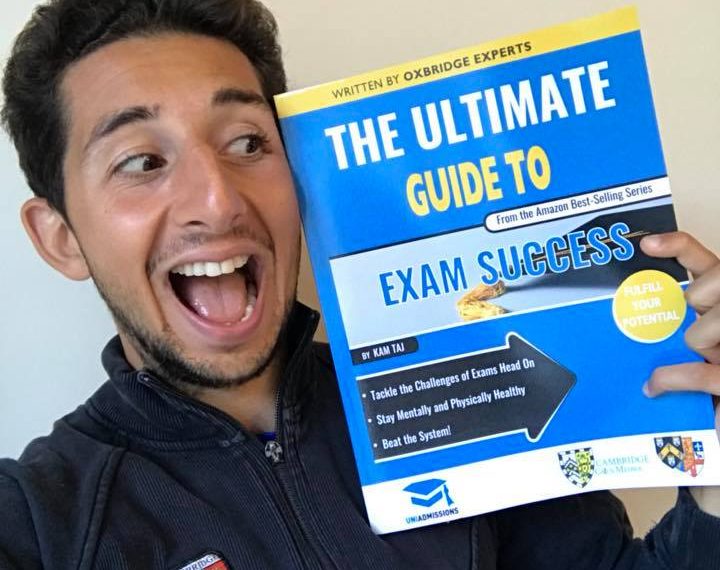
Performance coach Kam Taj’s new book offers students his own innovative and detailed holistic approach to achieving success as a student.
 Entitled The Ultimate Guide to Exam Success, the book is the latest in a series published through UniAdmissions, an education consultancy which helps students applying to Oxbridge and medical schools.
Entitled The Ultimate Guide to Exam Success, the book is the latest in a series published through UniAdmissions, an education consultancy which helps students applying to Oxbridge and medical schools.
Announcing its publication, Kam (Kamran Tajbaksh, OE 2004–2011) told his Facebook followers: “In many ways, I wrote this book for my younger self – it’s everything I wished I knew as a student and teenager.
“For those of you who don’t know, I graduated from Cambridge University with a 1st class in Engineering. But my path was anything but smooth. I went from failing my A-level Further Maths mocks to getting an A* and meeting my offer. I only achieved my 1st class after getting 2.2 grades in my first two years at Cambridge. I tell my story in more detail in the book, as well as sharing the tools and techniques which helped me to transform my failures into success – and have helped many of my private clients since.”
The first four chapters of the 182-page paperback are on: time-management, study tools & techniques; mind-management and on-the-day performance.
“Unlike any other book on exams, the final four chapters are on optimising our lifestyle so we can stay physically and mentally healthy throughout our studies,” Kam adds. These chapters of the book, which is published by RAR Medical Services, look at: movement & physical activity; nutrition & hydration; sleep and support groups.
Kam studied Manufacturing Engineering at Churchill College, Cambridge. After graduating, he initially took up a post as a management consultant with a global company. However, he had begun doing performance coaching work while still at university and in 2016 left the consultancy world to concentrate fully on coaching and motivational speaking.
He works predominantly with students and young professionals, speaking at leading schools and universities. Last term, Kam visited QE to lead a workshop on Oxbridge preparation for 32 sixth-formers.
The content of the new book is similar to The 8 Principles of Exam Domination, which was self-published by Kam on Kindle last year.



 The Geographical Association announced that QE is among a select group of schools from across the country to receive the Secondary Geography Quality Mark (SGQM) for 2018–21.
The Geographical Association announced that QE is among a select group of schools from across the country to receive the Secondary Geography Quality Mark (SGQM) for 2018–21.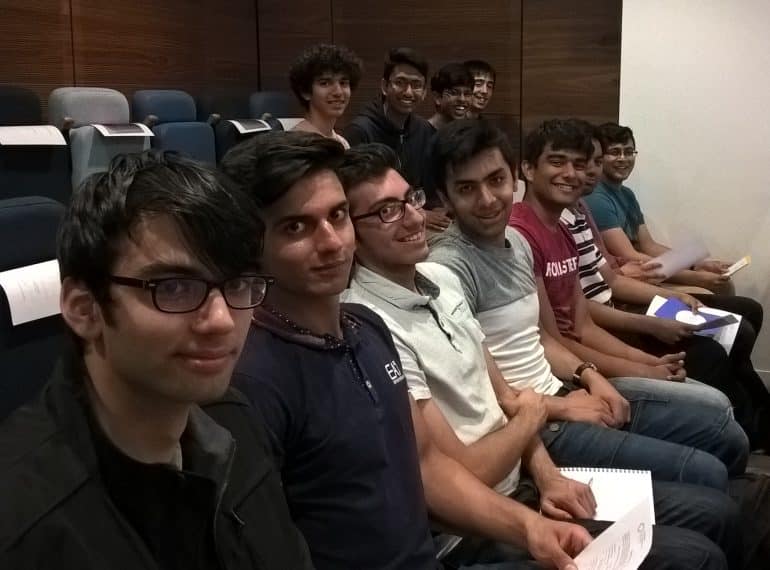
 For her lecture, Dr Steckles spoke on The Greatest Unsolved Puzzles in Maths. One of her demonstrations involved taking a piece of A4 paper and folding it three times, always folding along the longest edge, and then cutting off all four corners of the resulting shape. How many holes will you have made in the A4 paper when it is unfolded? she asked. (Answer: three). This led on to the introduction of the Euler brick which is a cuboid which has integer lengths and integer face diagonals. Some examples are shown in the image here.
For her lecture, Dr Steckles spoke on The Greatest Unsolved Puzzles in Maths. One of her demonstrations involved taking a piece of A4 paper and folding it three times, always folding along the longest edge, and then cutting off all four corners of the resulting shape. How many holes will you have made in the A4 paper when it is unfolded? she asked. (Answer: three). This led on to the introduction of the Euler brick which is a cuboid which has integer lengths and integer face diagonals. Some examples are shown in the image here.
 Assistant Head of Mathematics Wendy Fung said: “Each team was supervised by a Year 12 Further Maths student and it was a great opportunity for these sixth-formers to interact with Year 7, whether they were supervising a team or helping with the logistics of running the event: we couldn’t have done it without their help.” She pointed out that the Year 12 boys had themselves been participants in the inaugural Maths Fair, back in 2013.
Assistant Head of Mathematics Wendy Fung said: “Each team was supervised by a Year 12 Further Maths student and it was a great opportunity for these sixth-formers to interact with Year 7, whether they were supervising a team or helping with the logistics of running the event: we couldn’t have done it without their help.” She pointed out that the Year 12 boys had themselves been participants in the inaugural Maths Fair, back in 2013. All six Houses were also required to create a poster entitled What is Mathematics? Each of the teams within each House had to create part of the poster and was asked to prepare in advance by coordinating the different sections so that their poster would encompass the many facets of the subject.
All six Houses were also required to create a poster entitled What is Mathematics? Each of the teams within each House had to create part of the poster and was asked to prepare in advance by coordinating the different sections so that their poster would encompass the many facets of the subject.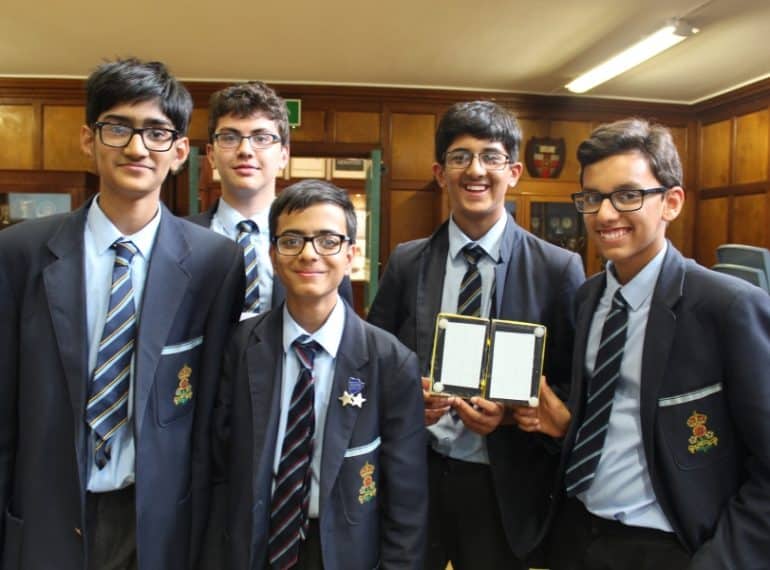
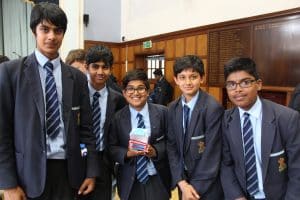 They had to design a product to solve a real-world problem, while also considering their marketing and business proposition. To create their prototypes, the participants were allocated a budget which they could use to buy the basic materials (such as card, tape and wooden sticks) from a ‘market’ in the hall.
They had to design a product to solve a real-world problem, while also considering their marketing and business proposition. To create their prototypes, the participants were allocated a budget which they could use to buy the basic materials (such as card, tape and wooden sticks) from a ‘market’ in the hall.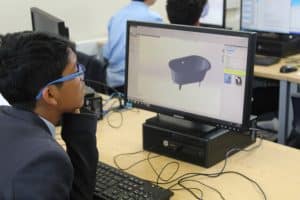 finance and business acumen to come up with a new product that was a practical proposition – and all in the space of a day. The boys successfully produced some very interesting and promising proposals.”
finance and business acumen to come up with a new product that was a practical proposition – and all in the space of a day. The boys successfully produced some very interesting and promising proposals.” Afterwards, Simon said: “The students were given the opportunity to design and develop ideas that use some new, cutting-edge technologies. I talked through a few new materials and the associated technology – and the students did the rest. They came up with a wide range of new product ideas, with the best being presented in the Dragons’ Den.”
Afterwards, Simon said: “The students were given the opportunity to design and develop ideas that use some new, cutting-edge technologies. I talked through a few new materials and the associated technology – and the students did the rest. They came up with a wide range of new product ideas, with the best being presented in the Dragons’ Den.”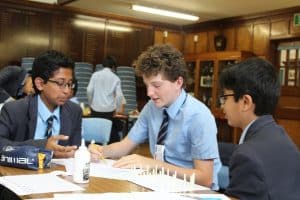 to charge a mobile phone. The second-day winners designed Simon’s particular favourite – SafeSensors, a sports helmet which not only protected the head but also had built-in impact sensors that could notify the team coach or doctor of any impact that would require a player to be treated or substituted (in cases of concussion, for example).
to charge a mobile phone. The second-day winners designed Simon’s particular favourite – SafeSensors, a sports helmet which not only protected the head but also had built-in impact sensors that could notify the team coach or doctor of any impact that would require a player to be treated or substituted (in cases of concussion, for example).